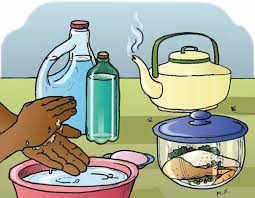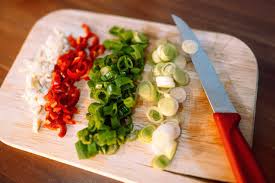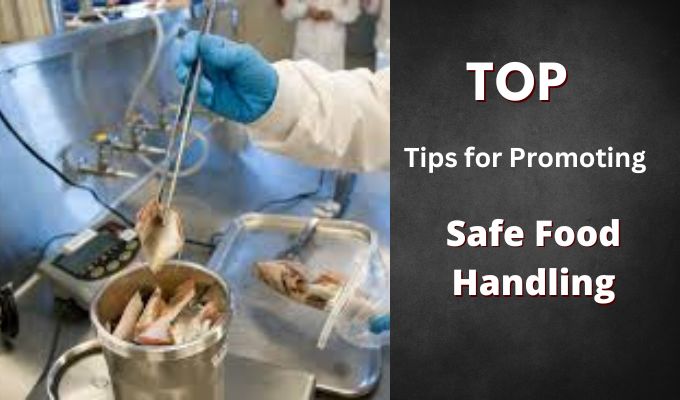“Ever wondered about the key to a healthy and happy life? It starts right in your kitchen! Welcome to the world of Top Tips for Promoting Safe Food Handling‘—where the magic of good health begins. Picture this: your kitchen as a sanctuary where every meal is a step towards well-being. By understanding and implementing the art of Promoting Safe Food Handling, you not only ensure delicious meals but also safeguard against unseen hazards. From washing hands before cooking to storing leftovers, join me in this journey of culinary wisdom. Together, let’s master the essential practices of Promoting Safe Food Handling for a nourished and joyful life!”

Guide: Promoting Safe Food Handling
Introduction:
Ensuring the safety of the food we consume is crucial for preventing foodborne illnesses. By understanding potential hazards and following recommended guidelines, we can minimize the risk of contamination and protect public health. This guide explores key aspects of promoting safe food handling, covering various topics related to food safety.
87 Languages Are Available:
Understanding the importance of safe food handling is essential across diverse communities. To reach a wider audience, educational materials on food safety are available in 87 languages. This inclusivity ensures that people from different cultural backgrounds can access and comprehend essential information about safe food practices.
Numerous Hazards Can Cause:
Identifying potential hazards is fundamental to safe food handling. Numerous factors, including improper storage, cross-contamination, and inadequate cooking, can lead to foodborne illnesses. Awareness of these hazards empowers individuals to take proactive measures to mitigate risks and protect themselves and others from food-related health issues.

Over 200 Types of Diseases:
There are over 200 types of diseases associated with unsafe food handling practices. There is a wide range of severity among these illnesses, from mild discomfort to . It is crucial to be aware of the diverse range of diseases that can result from foodborne pathogens, emphasizing the need for strict adherence to safety guidelines.
You Can Prevent Foodborne Diseases:
Preventing foodborne diseases is within our control. By adopting safe food handling practices, individuals can significantly reduce the risk of contamination and illness. Simple measures such as proper handwashing, thorough cooking, and careful food storage contribute to a safer food environment.
Related Technical Units:
Understanding the technical aspects of safe food handling is essential for professionals in the food industry. Training and education on topics like proper food storage, hygiene, and sanitation are crucial components of related technical units. Continuous learning ensures that industry practitioners stay informed about the latest safety protocols.
Campaign:
Public awareness campaigns play a vital role in promoting safe food handling practices. These campaigns aim to educate the general public about the importance of food safety and provide actionable steps to reduce risks. Engaging in such campaigns fosters a culture of responsibility and accountability in handling food safely.

News:
Staying informed about food safety news and updates is key to adapting to evolving challenges. Regularly checking reputable sources for information on food recalls, outbreaks, and emerging risks allows individuals to make informed decisions about their food choices and handling practices.
Five Keys to Safer Food
Poster:
Displaying educational materials, such as the “Five Keys to Safer Food” poster, in public spaces raises awareness about fundamental food safety principles. This visual aid serves as a quick reference guide, reminding individuals of key practices for safe food handling.
Publications:
In-depth publications, such as the “Five Keys to Safer Food” manual, provide comprehensive insights into safe food handling. These re

sources are valuable for individuals seeking a more detailed understanding of food safety principles and best practices.
Food Can Contain Superbugs?
Highlighting specific risks, such as the presence of superbugs in food, brings attention to emerging concerns in food safety. Understanding these challenges encourages proactive measures and promotes responsible consumer choices.
Five Keys to Safer Aquaculture Products to Protect Public Health:
Tailoring food safety guidelines to specific food categories, such as aquaculture products, ensures industry-specific measures are in place. This targeted approach enhances the safety of diverse food sources.
Five Keys to Growing Safer Fruits and Vegetables:
Addressing unique challenges associated with growing fruits and vegetables emphasizes the importance of safe agricultural practices. This publication provides guidance to farmers and growers to ensure the safety of their produce.
A Guide to Safe Food for Travelers:
For those on the move, a guide on safe food for travelers is essential. This resource offers practical tips for maintaining food safety during travel, and reducing the risk of foodborne illnesses away from home.
Multimedia:
Engaging multimedia resources further reinforces safe food handling principles. Videos, podcasts, and interactive content provide diverse learning experiences, catering to different preferences and learning styles.
Food Safety: Use Safe Water and Raw Materials:
Emphasizing the importance of using safe water and raw materials in food preparation is critical. Multimedia content on this topic reinforces key practices for preventing contamination at the initial stages of food handling.
Food Safety: Keep Food at Safe Temperatures:
To prevent bacterial growth, temperature control is essential. Multimedia resources focused on temperature management educate individuals on the significance of keeping food at safe temperatures during storage and preparation.
Food Safety: Cook Food Thoroughly
Cooking food thoroughly is a fundamental step in eliminating harmful pathogens. Multimedia content on this topic provides visual demonstrations and tips for ensuring that food is cooked to safe internal temperatures.
Food Safety: Separate Raw and Cooked:
Preventing cross-contamination is a key aspect of safe food handling. Multimedia resources illustrate effective methods for separating raw and cooked foods to minimize the risk of bacterial transfer.
Food Safety: Keep Clean!
Maintaining a clean food preparation environment is crucial for preventing contamination. Multimedia content on hygiene practices reinforces the importance of cleanliness in all aspects of food handling.
Five Keys to Safer Food
A multimedia presentation of the “Five Keys to Safer Food” reinforces these principles through engaging formats, making the information accessible to a broad audience.
Superbug in Food:
Awareness of superbugs in food is highlighted through multimedia content, educating viewers about the risks associated with antibiotic-resistant bacteria and the importance of responsible antibiotic use in food production.
Women in Senegal Take Part in Preventing Foodborne Diseases
Showcasing real-life examples, such as the involvement of women in Senegal in preventing foodborne diseases, inspires positive change. These stories demonstrate the impact of community engagement in promoting safe food handling practices.

In conclusion, promoting safe food handling is a multifaceted effort that involves education, awareness, and practical implementation of guidelines. By addressing various aspects of food safety, from individual practices to industry standards, we can collectively contribute to a safer and healthier food environment for everyone.
Conclusion:
In conclusion, promoting safe food handling is paramount for public health. By adhering to proper hygiene, and temperature control, and preventing cross-contamination, individuals and food establishments can significantly reduce the risk of foodborne illnesses. Government agencies, industry stakeholders, and community organizations must collaborate to disseminate information, provide education, and enforce regulations. Prioritizing safe food handling not only protects consumers but also contributes to a healthier and more resilient society. Ongoing efforts in education, regulation, and collaboration are essential for establishing a global framework for safe food practices.
FAQS:
Q1:How do you ensure safe food handling?
Ensuring safe food handling is crucial to prevent foodborne illnesses and maintain the quality and safety of the food we consume. There are several key procedures and techniques to follow in order to achieve this:
Q2:What are the 5 safe food handling procedures?
Ensuring safe food handling is crucial to prevent foodborne illnesses and maintain the quality and safety of the food we consume. There are several key procedures and techniques to follow in order to achieve this:
Cleanliness:
Wash hands thoroughly with soap and water before handling food.
Food-contact surfaces, utensils, and equipment should be cleaned and sanitized.
Separation:
Prevent cross-contamination by keeping raw meat separate from prepared foods.
Separate cutting boards should be used for raw meat and other foods.
Cooking to Safe Temperatures:
Ensure that food is cooked to its recommended internal temperature to kill harmful bacteria.
Use a food thermometer to check the internal temperature of meat, poultry, and other dishes.
Chilling:
Refrigerate perishable foods promptly to slow down the growth of bacteria.
Keep the refrigerator temperature at or below 40°F (4°C).
Safe Storage:
Store food items properly, following guidelines for refrigeration and freezing.
Label and date leftovers to track their freshness and avoid consuming expired items.
Q3:What are the four safe food handling techniques?
Personal Hygiene:
Emphasizes the importance of handwashing and maintaining overall cleanliness to prevent the spread of bacteria.
Cross-Contamination Prevention:
Focuses on keeping raw and cooked foods separate to avoid the transfer of harmful microorganisms.
Cooking and Temperature Control:
Stresses the significance of cooking food to safe internal temperatures to eliminate pathogens.
Storage and Preservation:
Highlights the proper storage of food, including refrigeration and freezing, to inhibit bacterial growth.
Q4:Why is food handling safe?
Food handling is considered safe when these procedures and techniques are consistently followed because they collectively minimize the risk of contamination and the growth of harmful bacteria. Adhering to these practices ensures that the food we handle is prepared, stored, and served in a manner that prioritizes both safety and quality.


